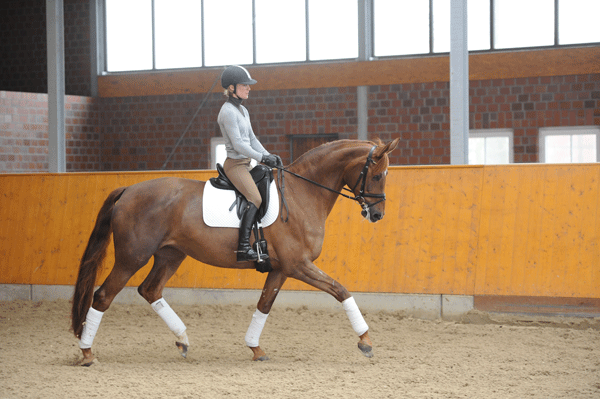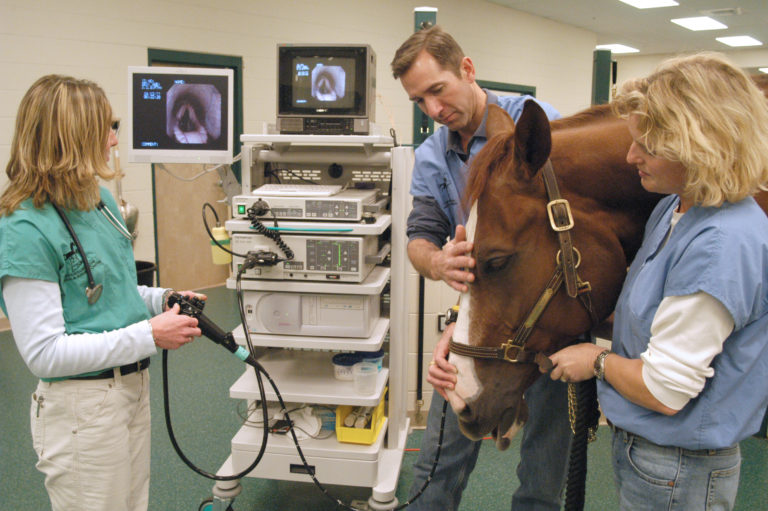Q: One instructor has told me to weight the inside seat bone when riding circles, voltes and shoulder-in. Another instructor in my barn advised me against this since it causes most riders to collapse their upper bodies or lose the outside seat bone, thereby losing their centeredness in the saddle. I’m completely confused. The seat bone to me seems like one of the most important aids a rider has. How do I weight it correctly when riding a volte, circle or shoulder-in?
—Name withheld by request
A: We all have had a chance to admire a talented rider who performs a perfect shoulder-in or volte and wondered, How did she get the horse to bend so effortlessly? The rider looked like she was floating with the horse, her chest squarely lined up with the horse’s chest, and her hips lined up with the horse’s hips. It did not look like the inside rein was used to produce a beautiful bend of the neck that continued through the body. One could not help but hum from the pleasure of watching this.

Then we have witnessed a rider who was trying the same movements but leaning to the inside with her upper body, her inside leg pulled up. Her inside elbow was clinging to her rib cage, which was caved in, and her outside elbow was sticking out, being pushed by the hips. The horse’s neck was overbent and his outside shoulder was falling out, creating a hinge between neck and body.
Did the first rider weight her inside seat bone more to create the bend? The answer is most likely yes. Did the second rider weight her inside seat bone more? I bet if you’d ask her, she would say, “Yes,” adding, “because the inside seat bone felt like it had more contact with the saddle.”
In reality, however, by leaning more to the inside with her torso, the second rider caused more of her weight to fall to the outside, with the outside seat bone being pushed so far out that the rider could not even feel it on the saddle. The rider felt her inside seat bone more because it was placed closer to the centerline of the saddle. The horse, trying to balance himself under the rider’s weight, drifted toward the outside, falling over his shoulder. The bend was not through the horse’s whole body.
Only his neck was pulled in by the rider’s hand.
By now you probably have realized that both of your trainers were right when advising you.
Yes, the rider’s weight in the saddle is important when asking the horse to bend in the corners, on bent lines and in lateral movements that require bend. But before you start working on such intricacies as weighting one seat bone more than the other, be sure that you have mastered balance by having an independent seat. This means that you are able to balance on both seat bones without holding on to the reins or gripping with your thighs and knees. The core muscles that are in charge of your balance when standing and sitting must be trained to be able to support and balance you when you are sitting on the horse. When a horse stands still, this is relatively easy. When he is in motion, this balance becomes more difficult to obtain.
The best way to learn to balance on the horse is to spend time on him. Taking longe-line lessons is helpful. There are other ways to work on your balance, too. For example, sitting on a balance ball, doing martial arts, Pilates or yoga all help to build core strength and improve balance.
Once you have established your independent seat and you feel that you are in balance with your horse, you can start experimenting with weighting one seat bone more when riding on a circle. You may realize now how sensitive the horse is and that you don’t need to do much more than line up your hips with his hips to achieve this. In other words, push your inside hip a bit forward. This, together with dropping your inside knee and allowing a bit more weight in your inside stirrup, will be enough. Then you may feel the inside seat bone just a little bit more.
Next, try riding a figure eight. When changing direction, sit a couple of strides in the middle when crossing the centerline. Then push your new inside hip forward. Remember, your shoulders need to be lined up with your horse’s shoulders when bending him. Imagine a movie camera in the middle of your chest. Point the camera between your horse’s ears. That will help you line up your shoulders with his shoulders. An educated eye is always helpful when working on the seat. A trainer may not be available for your every ride. Here a mirror or a helpful friend may prove useful.
We all strive for the perfect seat. Developing it takes constant work and willingness to feel and listen to the horse. Most of all, though, be patient.
This article first appeared in the September 2014 issue of Dressage Today.
Click here to read more articles with Kirsi Nevalainen.
Kirsi Nevalainen
is a USDF Certified Instructor through Fourth Level. A native of Finland, she trains horses out of Faass Farm in Rancho Capistrano, California, and works with Axel Steiner in monthly clinics.











